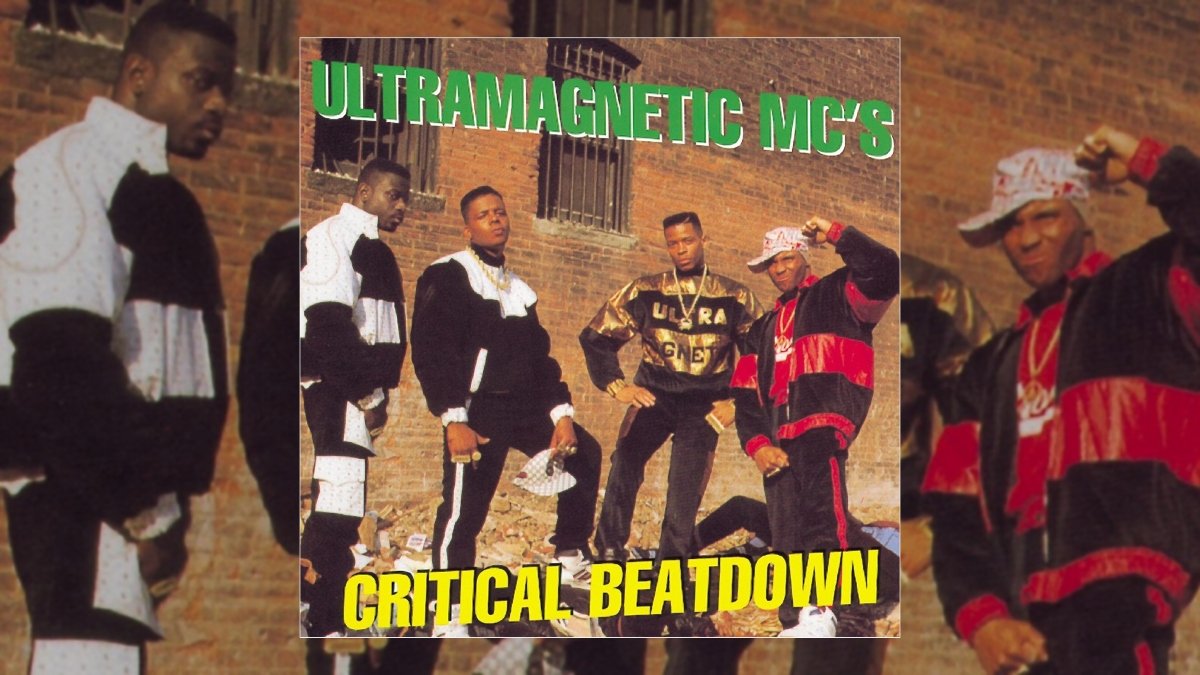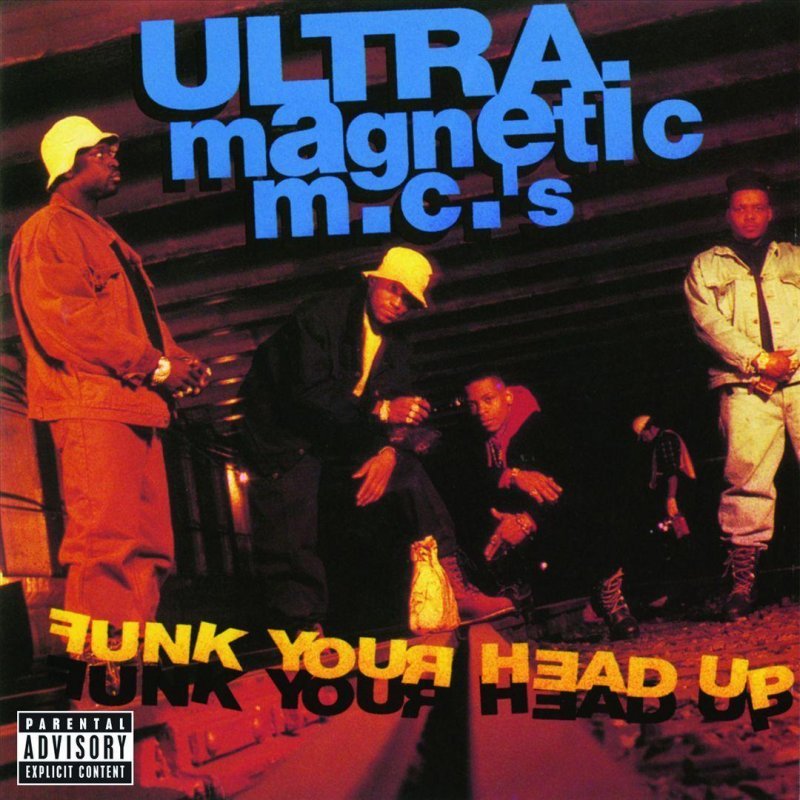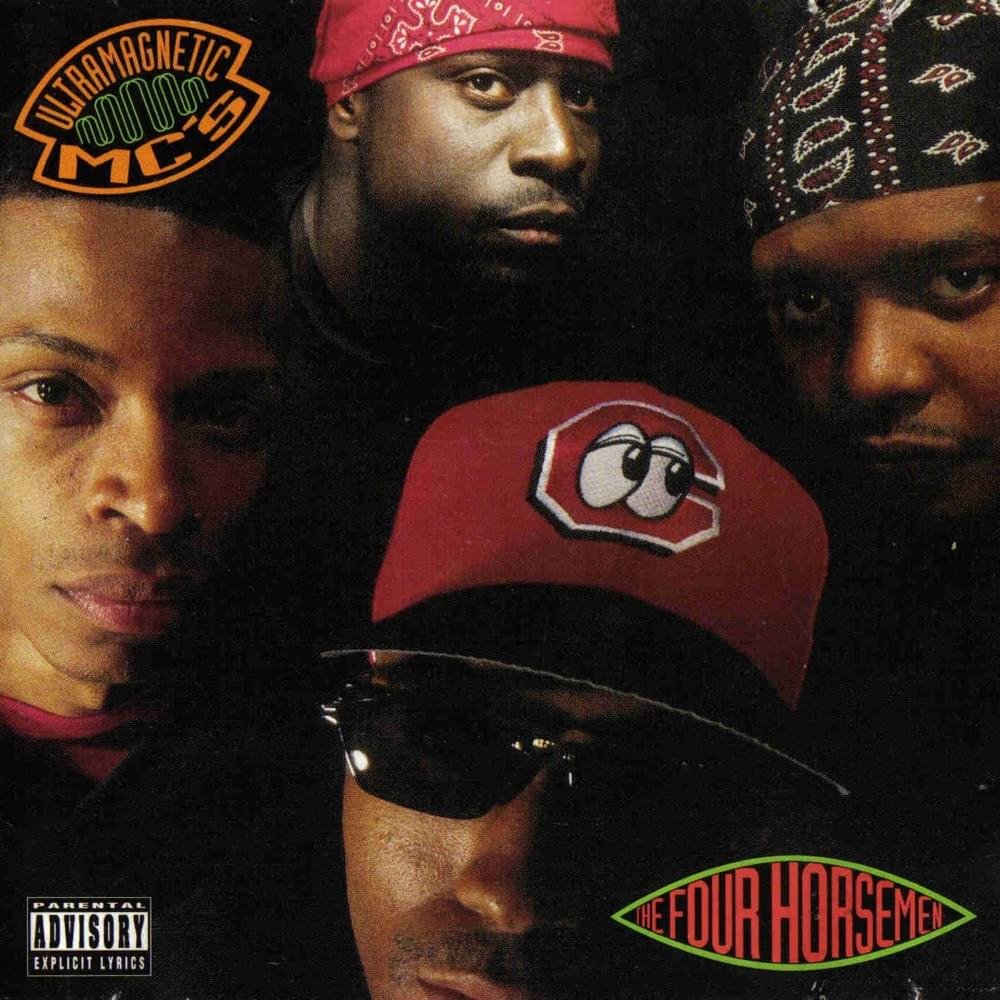Happy 35th Anniversary to Ultramagnetic MCs’ debut album Critical Beatdown, originally released October 4, 1988.
When describing works of art, the term “dated” is usually used pejoratively. It suggests the song or album or film, although once considered popular or innovative, has lost its luster as the years have passed. I’ll admit that I’ve frequently used “dated” in that context, just as I’ve used the term “timeless” quite often when writing these tributes. The latter term suggests that even though an album was recorded many years ago, its themes are still “relevant” (another term I hate but still use).
In the case of Ultramagnetic MCs’ debut long player Critical Beatdown, the album is dated in that there’s no doubt that it only could have been released 35 years ago. And yet, despite sounding like the product of its era, it’s still in the top tier of hip-hop albums ever released. In a year crowded with timeless (see?) albums, I’ve got it probably only behind Public Enemy’s It Takes a Nation of Millions to Hold Us Back (1988). I’d also rank it somewhere between #5 & #10 of the greatest hip-hop albums ever.
Ultramagnetic MCs were the product of the Bronx rapper “Kool” Keith Thornton, rapper/producer Cedric “Ced-Gee” Miller, producer/rapper Trevor “TR Love” Randolph, and DJ/producer Maurice “DJ Moe Luv” Smith, who had learned about hip-hop culture through the park jams and discos of the late ’70s and early ’80s. Yet they were one of the first groups to attempt to really expand the genre’s boundaries.
When Critical Beatdown was released three-and-a-half decades ago, the album and Ultramagnetic MCs were very much ahead of their time. In terms of the styles, techniques, and rhyme schemes, it was like Ced and Keith were speaking a different language. In terms of production, Ced and engineer Paul C were innovators behind the boards, utilizing the SP-12 sampler in ways that were unheard of back in 1988.
Considering how great Critical Beatdown is, it’s amazing that it came together so quickly. The beats from the album were cobbled together from the Ultimate Beats and Breaks collection and James Brown records. From the group members’ accounts, all of the raps were practically freestyled: the pair scribbled down their rhymes immediately before entering the recording booth, reading them off the paper before the ink was dry. There’s no deep lyrical content, as Ced and Keith almost exclusively talk about their skills on the microphone. But they do so more utilizing complicated cadences and advanced wordplay.
Ultramagnetic attacks beats with all styles and tempos, working with precision on mid-tempo jams like “Ease Back,” “Feelin’ It,” and the title track. However, they excel when rapping at break-neck speeds over 100+ BPM tracks, like “Ain’t It Good To You.”
Listen to the Album:
The rapid rate at which Ultramagnetic put together their rhymes leads to interesting idiosyncrasies throughout the album. Ced has a penchant for rhyming “smoke,” “dope,” and “choke” in rapid succession. Keith likes threatening to beat people in the head with a baseball bat. He also uses words like “jocketable.” Both call wack emcees “ducks,” and, to a lesser extent, roaches. Both like to introduce themselves in the middle of their verses. As in Ced’s “Hello!….I’m back again!” or Kool Keith’s “Hello! How are you doing?” All of these oddities give the album as a whole unmistakable character.
Ultramagnetic first really became known on the strength of their single “Ego Trippin’” in 1986. It was absolutely unlike any other hip-hop track on the market at the time. Lyrically, Ced and Keith were pioneers, their rhyme flows completely unorthodox, as they stuttered and stopped and re-started. The two went off the beat and then back on like it was perfectly natural.
And they sprinkled their rhymes with a vocabulary rarely used by other artists. Back in ’86, Keith must have sounded like an alien creature as he rapped, “By the flame of the lyrics which cooks the human brain / Providing overheating knowledge, by means causing pain / Like a migraine headache, your cells start to melt / While the Technics spin, the wax is on the felt.” During his first verse, Ced doesn’t even rhyme. “Igniting causing friction with nuclear alarms,” he raps. “Separates competing biters from me, the scientist / As I execute, lyricist, known as predators / When by stripping high potents and making penicillin.”
Musically, “Ego Trippin’” features one of the first known uses of Melvin Bliss’ “Synthetic Substitution,” one of the most popular drum breaks in hip-hop history. Ced then takes the opening piano note and re-freaks it throughout the track, playing it in different sequences. The only slight issue is that though the 12” version of the track is over five minutes long, the album version stops after the first two verses for no discernable reason. Regardless, “Ego Trippin’” remains highly influential three decades later, and essentially spawned the entire genre of underground, left-of-center hip-hop.
Chuck D once called Ultramagnetic the “Kings of singles,” which is a pretty apt description. In the two years before Critical Beatdown was released, they dropped many singles, some of which never made the album. Among those that did, like the aforementioned “Ego Trippin,’” they often appeared in different form. The remixed or re-recorded versions that appear on Critical Beatdown often work best in the flow of the album, rather than as standalone singles.
The somewhat slick 12” version of “Funky” is transformed into a rugged head-knocker track, built around the break from The Fatback Band’s “Fatbackin’.” The largely bizarre 12” version “Travelling at the Speed of Thought” is replaced with a straight ahead high-octane rap track. Though both versions make use of The Rolling Stones’ “Honky Tonk Women” and The Kingsmen’s “Louie Louie,” Ced and Keith deliver relatively straight-ahead verses (for them) in place of the strangely shouted and clipped phrases on the original version.
Enjoying this article? Click/tap on the album covers to explore more about Ultramagnetic MCs:
“Give the Drummer Some” is best known for its innovative production techniques. On the track, Ced and Paul C showcase some of the first known uses of the “pan” and “chop” techniques. The latter technique involves taking a known drum break, chopping it down to its component parts (kick, snare, etc.) and then replaying them manually through the SP-12 drum machine/sampler. For “Give the Drummer Some,” Paul C chopped up the drums to Dee Felice Trio’s “There Was a Time” and re-sequenced them in such a way that to this day it still stumps super-producer Pete Rock. Lyrically, both emcees come correct as usual, with Keith shining with lines like, “Whatever group or vest in line / I put ’em all behind / Play ‘MC Ultra’ as a warning sign / Of my skill, and what my mind deserves / I smell a grape in the duck preserves.”
“Break North” foreshadows the group’s transformation into its darker and more sinister incarnation. Over pounding drums, blipping synths, and vocal samples from Star Wars, Ultramagnetic rock in front of a massive crowd in Massachusetts (who knew the Boston Civic Center had the capacity to hold 55,008,009?). Keith’s verse suggests the surfacing of the Dr. Octagon/Dr. Dooom personalities nearly a decade ahead of time, as he assumes the role of a serial killer. “I'm iller, a South Bronx killer,” he raps. “I chop rappers, and throw ‘em in the river / Tasting, as I swallow your liver / Here's your brain for your girl I can give her / Messages, clues from a murderer / And if she's ugly, I never even heard of her.”
Kool and Ced also shine on their own solo tracks, each getting two showcases on the album. “Kool Keith Housing Things” and “When I Burn” are both exquisite exhibitions in rapid-fire rapping. Ced keeps things at a more deliberate pace, first with the brief “One Minute Less” (actually a hair under two minutes in length) and the self-titled “Ced Gee (Delta Force One).” The latter is the album’s mellow closer, featuring Ced rhyming over one of the early uses of Bob James’ “Nautilus,” swinging across the beat using interlocking rhyme schemes, rapping, “Bringing your dreams to reality / And by the formality of thoughts / Yes, atomic of course / You stepping to me? You take a loss / Radical, the replication of a quasar / A pulsar, immense to supplicate / Crush a germ, then further eradicate.”
Even though Critical Beatdown was their high-water mark, Ultramagnetic would continue to pioneer and experiment with new sounds and styles. As mentioned before, they would go on to influence countless artists; it’s hard to imagine a world with De La Soul, Hieroglyphics, MF DOOM, Run The Jewels, or others without Ultramagnetic MCs leading the way. The ability to take techniques that seem so simple and execute them in a mind-bogglingly complex way, without looking like they’re even trying, is an amazing feat. And it’s what makes Critical Beatdown a timeless achievement.
LISTEN:
Editor's note: this anniversary tribute was originally published in 2018 and has since been edited for accuracy and timeliness.



